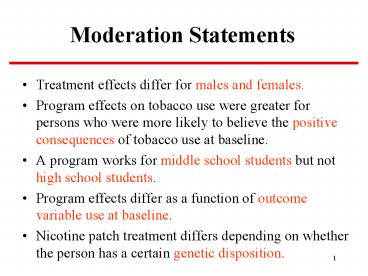Moderation Statements - PowerPoint PPT Presentation
1 / 14
Title:
Moderation Statements
Description:
Program effects on tobacco use were greater for persons who were more likely to ... differs depending on whether the person has a certain genetic disposition. ... – PowerPoint PPT presentation
Number of Views:41
Avg rating:3.0/5.0
Title: Moderation Statements
1
Moderation Statements
- Treatment effects differ for males and females.
- Program effects on tobacco use were greater for
persons who were more likely to believe the
positive consequences of tobacco use at baseline. - A program works for middle school students but
not high school students. - Program effects differ as a function of outcome
variable use at baseline. - Nicotine patch treatment differs depending on
whether the person has a certain genetic
disposition.
2
Moderators
- Moderators determine for whom the program is
effective. - Mediation assumes no moderation effect It is
assumed that the relation from X to M and from M
to Y are homogeneous across subgroups or other
characteristics of participants in the study.
3
Importance of Moderation in Prevention and
Treatment Research
- Information on moderating variables can be used
to identify the groups of persons who will
benefit the most (and least) from a program. - In some cases, important theoretical predictions
can be tested. For example, if program effects
depend on the level of risk.
4
Mediator versus Moderator
- Moderator is a variable that affects the strength
or form of the relation between two variables.
The variable is not intermediate in the causal
sequence, so it is not a mediator. - Moderator is also an interaction, the relation
between X and Y depends on a third variable.
There are other more detailed definitions of a
moderator. - Tested by including interaction effects in
addition to main effects of X.
5
Moderation Analysis 1
- Group 1
- Y1 i1 d1 X e1
- Group 2
- Y2 i2 d2 X e2
- Combined Groups
- Y i1 c1 X c2 Z d3 XZ e2
- d3 d1 - d2 and provides a general way to test
moderator/interaction effects.
6
Moderation Analysis 2
- Centering is important in moderation analysis in
order to reduce multicollinearity and
interpretation of interaction effects. Centering
consists of subtracting the mean from each
observed score for X and Z (see Aiken West,
1991). - The combined model and test for d3 is a general
way to test moderator effects for both continuous
and categorical moderators. - In regression analysis, the interaction variable,
XZ, is the product of the centered X variable and
the centered Z variable. - Power to detect moderator effects is often very
low (Aiken West, 1991) - Plots are important for the interpretation of
moderator effects.
7
Models with Moderation and Mediation
- Moderated and Mediation may occur simultaneously
in several different ways. - Relation of X to M may differ across levels of X.
- Relation of M to Y may differ across levels of X.
- Both X to M and M to Y relations may differ.
8
Moderated and Mediation
c1
a1
b1
Group 1
X
M
Y
a2
b2
Group 2
X
M
Y
c2
Separate mediated effect in each group a1b1, a2b2
9
Mediation and Moderator Models
- Ho a1- a2 0 is a test of homogeneous action
theory, called mediated moderation in Baron and
Kenny (1986) - Ho b1- b2 0 is a test of homogeneous
conceptual theory, called moderated mediation in
Baron and Kenny (1986). - Ho c1- c2 0 is a test of equal direct
effect. - Ho a1b1 a2b2 0 is a test of moderated
mediation. A test of whether the mediated effect
differs between groups. - Extend to more than two groups by forming
contrasts among mediated effects.
10
Separate and Combined Group Moderation and
Mediation
- Group 1
- Y1 i11 c11' X b11 M e11
- M1 i21 a11 X e11
- Group 2
- Y2 i12 c12' X b12 M e12
- M2 i22 a12 X e22
- Combined Groups
- Y i1 c1' X c2' Z c3' XZ b1 M b2 MZ
e2 - M i1 a1 X a2 Z a3 XZ e3
11
Mediation and Moderator Models
- Ho a11- a12 0 is the same as Ho a3 0. Test
of homogeneous action theory, called mediated
moderation in Baron and Kenny (1986) - Ho b11- b12 0 is the same as Ho b2 0. Test
of homogeneous conceptual theory, called
moderated mediation in Baron and Kenny (1986). - Ho c11- c12 0 is the same as Ho c3 0.
Test of equal direct effect.
12
Mediation of Baseline by Treatment Interactions
(MBTI)
- Program effects are often largest for persons
lowest on the mediator at baseline. - The mediation effect may differ at the levels of
the baseline mediation variable. - If the interaction is nonsignificant then assume
constant mediation effect. - If the interaction is significant then the size
of the mediated effect depends on baseline
values.
13
MBTI (Morgan-Lopez, 2003)
a
1
X
M
1
2
a
2
a
3
M
1
b
c
1
c
2
X
M
1
1
c
3
c
Y
4
Y
2
1
14
Summary
- Mediation and Moderation analyses address
important questions in prevention and treatment
research--How and for whom do programs work? - Some research investigating mediation and
moderation separately but still too few studies. - Actual program effects may contain mediation and
moderation simultaneously. - Equations to test these models were described.
- Models with mediation and moderation reflect the
complexity and richness of drug research.































